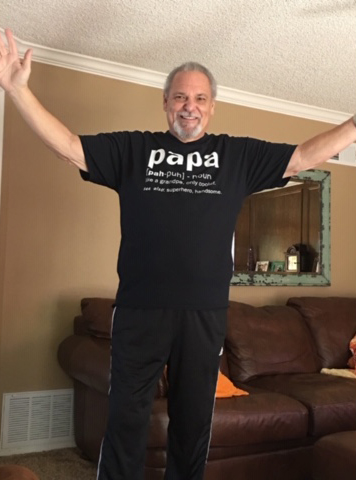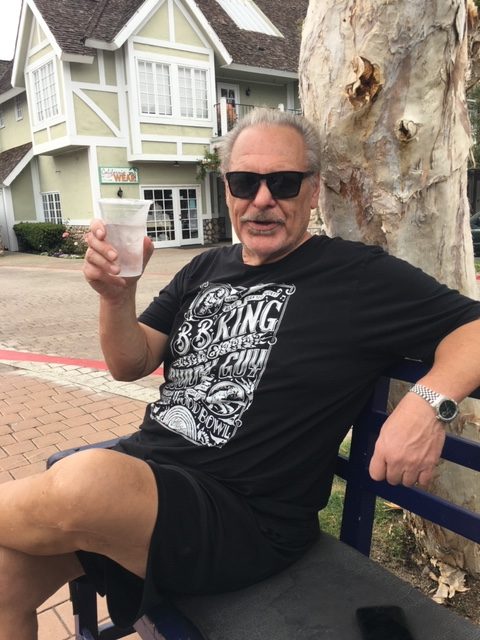Tony
Life before surgery
Tony B. came to the Oliak Center for Weight Loss in 2018 at the urging of his primary care physician, Shashidhar Acharya MD, in Orange, CA. For the previous 5 years, his doctor had been pushing him to lose weight. But Tony really struggled to make the dietary and physical activity changes that his doctor recommended at each visit.*
“I couldn’t stick to a diet—I just got too hungry. I’d try to eat less but when your stomach is used to eating 2 cheeseburgers instead of one, 6 tacos instead of 3, it’s practically impossible. Dr. Oliak told me later that my stomach probably held 30-40 ounces of food back then. It was hard to feel full and satisfied on less than that amount of food.
“At best, I could lose 20lbs with a diet, but 2 months later I’d gain it right back. I’ve always been a big athletic guy, so at 6’2” and 375lbs, people always told me ‘you carry it well.’ But I didn’t carry it well. Everything hurt. As I got older, my legs and knees started bothering me. It makes sense. Hauling around that extra weight creates a lot of stress.”
Tony’s PCP recommended Dr. Oliak—and Tony trusts his PCP implicitly. “In 2010, Dr. Acharya ordered a CT scan for an abdominal infection that also picked up cancerous spots on my right lung. I ended up having the lower lobe removed. I really credit him with saving my life.”
“He’s followed me closely ever since and at each medical appointment he’d go over my lab work. I had high blood pressure, high cholesterol, and elevated triglycerides. That’s why he kept trying to get me to lose weight. But I just couldn’t do it, and that’s when he sent me right to Dr. Oliak for a consultation.”
Tony’s weight loss surgery consultation with Dr. Oliak
Tony scheduled his free, no obligation consultation with Dr. Oliak. “He impressed me so much during that consultation, I thought, ‘I’m ready for this.’”
When Dr. Oliak met with Tony, he spent 60 minutes going over his health history, what the surgery would involve, and what he’d have to do to qualify for surgery.
“After that consultation I knew I wanted Dr. Oliak to do my surgery. First off, he has such passion for what he does. It was clear from the beginning that he was motivated by a desire to help me more than anything else. Some surgeons meet you and say, ‘Let’s go do this on Monday.’ Not Dr. Oliak. He wanted me to lose 15 pounds before he would do the surgery, because it would create more room in my abdomen for laparoscopic surgery, which is the less invasive and lower risk way to do the operation. ”
Dr. Oliak believes patient education is an important component of successful weight loss surgery—and patient education starts right with that first visit. “I think it’s important for my patients to understand how difficult it is to lose weight through diet and exercise alone. Many of them come in blaming themselves (or worse) because they haven’t been able to lose weight.”
“The truth is, when a person starts losing weight, their body starts to defend against this ‘threat.’ This weight that your body wants to defend is known as the body weight set point, which is the weight your body thinks is normal and therefore healthy. The body fights to stay at the set point through the weapons of increased appetite and decreased metabolism. For every 1 kilogram (2.2lbs) of weight lost through diet and exercise, appetite increases by about 100 calories per day. And metabolism decreases by about 20-30 calories per kilogram per day. As a result, the person trying to lose weight gets hungry to make them eat more calories, and their metabolism slows so they don’t burn them off so fast.”
“For Tony, that 20lbs he lost through diet and exercise meant that this body increased his appetite by approximately 900 calories, and decreased his metabolism by 180-270 calories per day. It’s no wonder that he would ultimately gain the weight back. 95-98% of people fail to lose weight and keep it off.”
During the consultation, Dr. Oliak and Tony decided together that sleeve gastrectomy (also known as vertical sleeve gastrectomy, VSG, gastric sleeve, or simply sleeve) would be the lower-risk surgical option for Tony.
“At 6’2” and 375lbs, Tony had a BMI of 48, which made him a candidate for gastric sleeve or gastric bypass. I favored the gastric sleeve for Tony because it’s a less invasive surgery, and it preserves a more normal experience of eating (aside from eating less). I tend to favor the gastric bypass for people with diabetes or significant GERD—neither of which Tony had.”
The surgery, recovery, and support
During Tony’s sleeve gastrectomy surgery, Dr. Oliak removed a substantial portion of his stomach to reduce the stomach volume from approximately 30-40 ounces to a mere 4 ounces. The smaller stomach limited the amount of food (and calories) Tony could eat, and effectively reset his body weight set point to a lower, healthier weight.
The operation was done laparoscopically, and took approximately 2 hours. Recovery time is typically rapid, with patients being discharged from the hospital the day after surgery and returning to work in 1-2 weeks.
Tony however returned to work the following week (with Dr. Oliak’s approval, of course). “I had ZERO pain after the surgery. I only felt a little sore, maybe a little tightness. At the time I had a desk job so I knew I could return to work ASAP.”
For the first month after surgery, Tony followed the strict diet that Dr. Oliak gave him: at first only liquids and then gradually soft foods. “I drank a lot of protein shakes in little sips and ate a lot of eggs really slow. That’s the toughest time I had, because I wanted to eat real food. After 2 weeks I wanted to have a piece of meat already! But I knew I had to follow what Dr. Oliak wanted me to do. I wanted to be successful. I’d seen his other patients’ results. I had confidence in his abilities, guidelines, and recommendations.”
It wasn’t too hard, however, to restrict himself to 600 calories a day. “The focus was on eating food with protein in it. I’d never had to think about it so much, and if you’d asked, I would have told you ‘I had a steak, of course I’ve had plenty of protein.’ Now I see how I was eating a lot of the wrong things all along.
“Eating better has been wonderful for my energy level. I had more energy than I could ever remember, and I guarantee if you talk to 10 weight loss surgery patients, you’ll hear that 10 times.”
Life after surgery
Tony had his surgery in July of 2018. Less than 2 months after the surgery, he was able to stop taking his blood pressure pills that he’d been taking for 14 years. And that was after losing “only” 30lbs in those first 2 months.
In total, Tony’s lost 96lbs and says it’s a monkey he has off his back. He feels lighter on his feet and so much more energetic. “Dr. Acharya says I’ve added another 10-15 years to my life.”
Tony has never gained back the weight he lost. At the time of this writing, the country is in the middle of the COVID-19 pandemic. Tony proudly reports that despite being mostly cooped up at home, he’s only gained one pound. (Dr. Acharya agrees this does not count.)
The biggest difference is that Tony can play with his “young and very active” grandkids, and enjoy it. “We can play catch, I can chase them around. They’ve definitely noticed the change. Before they would tease me and ask, ‘Hey Papa, why’s your stomach so big?’ but now my stomach isn’t big anymore. So they tease me, ‘Hey Papa, how come you’re losing your hair?’ They used to think of me like a Santa Claus but now they don’t.
“It’s just amazing what this surgery has done for my life. Now it’s fun to go for a walk, climb that hill, walk that theme park. I can do so many things I hadn’t had the energy to do. It’s made all the difference in the world.”




